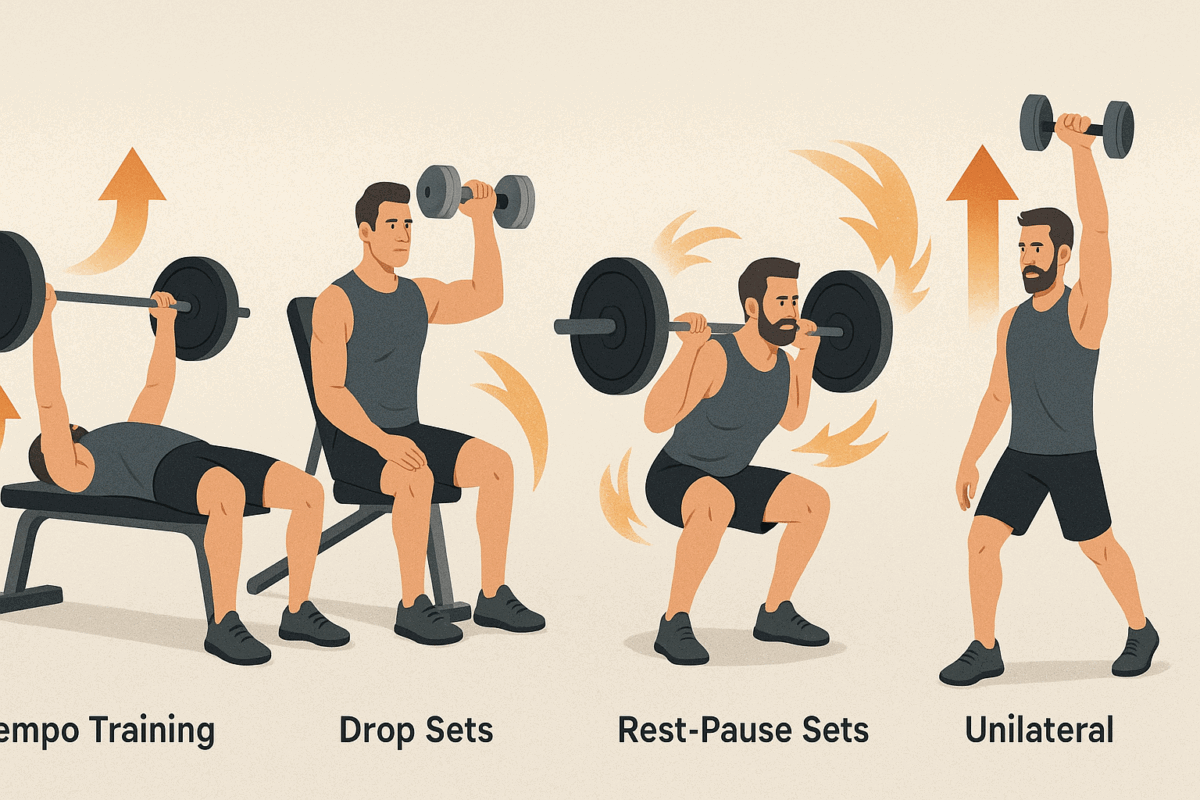Introduction: Why Getting in Shape Fast Is Possible with the Right Strategy
For men who are determined to make a rapid transformation in their physique and health, understanding how to get in shape fast for men involves much more than hitting the gym randomly or following trendy diets. It requires a focused, scientifically grounded plan that blends strength training, recovery, and nutrition into a cohesive lifestyle strategy. Many males, particularly those juggling demanding careers or academic schedules, often assume that getting in shape is a slow, linear process. However, with intelligent programming and deliberate effort, fast and sustainable results are absolutely achievable. This guide will explore not only the principles behind effective strength training but also the psychological and physiological techniques that support rapid improvement for in shape men seeking meaningful change.
You may also like: The Ultimate 30-Day Workout Plan for Men Working Out in the Gym: Proven Full Body Strength Exercises to Maximize Results
Understanding the Science Behind Strength Training for Rapid Results
To build a well-structured approach to fitness, it is crucial to start with the science of strength training. Resistance training stimulates muscle hypertrophy, which is the enlargement of muscle fibers due to repeated tension and microtrauma. When the body repairs this microtrauma, it becomes stronger and more resilient. For men aiming to improve their physical condition quickly, compound lifts such as squats, deadlifts, and bench presses engage multiple muscle groups and promote faster overall development. Neuromuscular adaptation also plays a significant role; as you continue to train, your nervous system becomes more efficient at recruiting motor units, leading to increased strength even before noticeable muscle growth.
Equally important is the principle of progressive overload. By gradually increasing the amount of resistance or volume, the body is continually challenged, forcing it to adapt and grow stronger. Men should aim to increase either the weight lifted, the number of sets or reps, or the intensity with which exercises are performed week over week. Tracking these metrics ensures continued progress, helping in shape men avoid plateaus and accelerate their transformation.

How to Get in Shape Fast for Men Through Consistent Programming
One of the most overlooked elements in fast physique transformation is consistency. It is not the occasional intense workout that changes your body, but rather the accumulated effect of regular, structured training. Men looking for how to get in shape fast must prioritize weekly training splits that focus on different muscle groups and incorporate rest appropriately. A typical beginner-to-intermediate program might follow a push-pull-legs split, performed 4 to 6 times per week depending on recovery capacity.
Periodization also enhances results. This involves cycling through phases of different training intensities and volumes, such as hypertrophy phases (8-12 reps), strength phases (3-6 reps), and deload weeks to reduce fatigue. Periodization allows the body to recover while still improving over time. Properly programmed strength training prevents overtraining and ensures that each muscle group is stimulated often enough to grow but not so frequently that recovery becomes compromised.
Moreover, integrating full-body functional training days—featuring kettlebells, resistance bands, and bodyweight circuits—adds variety, burns additional calories, and supports cardiovascular health. This balance between strength work and metabolic conditioning is crucial for men who want to look lean and strong in the shortest amount of time.

Optimizing Nutrition to Support Fast Body Composition Changes
Nutrition is the silent driver behind every successful strength training plan. You can train diligently, but without proper fuel, progress will stall. For in shape men who aim to improve their physiques rapidly, a focus on macronutrient timing, quality food sources, and caloric balance is critical.
Protein is the cornerstone of muscle repair and growth. Men should consume at least 1.6 to 2.2 grams of protein per kilogram of body weight daily, spaced evenly throughout meals. High-quality sources such as lean meats, eggs, dairy, fish, and plant-based proteins (like legumes and tofu) provide the essential amino acids needed to support hypertrophy. Carbohydrates are often misunderstood but are essential for fueling workouts and aiding in recovery. Whole grains, fruits, and vegetables offer glycogen replenishment and micronutrients.
Dietary fat should not be neglected. Healthy fats from nuts, seeds, avocados, and fatty fish support hormone production, especially testosterone—a key hormone in muscle development. Strategic use of nutrient timing, such as consuming a mix of protein and carbs post-workout, can enhance muscle protein synthesis. Finally, hydration and sleep—often underestimated—play indispensable roles in muscle recovery and energy levels.

How to Get in Shape Fast for Men with Compound Lifts and Functional Movements
Training efficiency becomes a priority when time is limited. One of the most effective ways to get in shape quickly is through compound lifts. These multi-joint exercises, like squats, deadlifts, and pull-ups, activate large muscle groups and offer a powerful metabolic stimulus. Because these lifts require greater muscular coordination and energy expenditure, they burn more calories and build more mass than isolation exercises.
Incorporating functional movements into your training regimen enhances not only strength but also balance, mobility, and endurance. Movements such as kettlebell swings, sled pushes, farmer carries, and medicine ball slams integrate core engagement and improve athletic performance. Men who want to fast-track their conditioning and muscle tone should prioritize these full-body movements over machine-based training.
High-Intensity Interval Training (HIIT) complements strength training by accelerating fat loss without sacrificing muscle mass. A well-designed weekly training schedule might include three days of heavy lifting, two days of HIIT or metabolic conditioning, and two active recovery days featuring mobility work or low-impact cardio like cycling or walking.

Strategic Recovery: The Hidden Key to Faster Results
Training hard is important, but without adequate recovery, progress will stall. Muscle repair and growth occur not during workouts but in the hours and days following them. For men focused on how to get in shape fast male, incorporating deliberate recovery strategies is essential to avoid burnout and injury.
Sleep is perhaps the most underrated recovery tool. Seven to nine hours of high-quality sleep per night optimizes testosterone levels, enhances memory and focus, and supports muscle repair. Active recovery, including stretching, foam rolling, and light cardio, improves circulation and reduces soreness, making it easier to train consistently throughout the week.
Deload weeks—periods of reduced training volume or intensity every four to six weeks—give the nervous system and connective tissues a break. This approach prevents overuse injuries and promotes long-term sustainability. Finally, stress management techniques such as mindfulness, meditation, or breathing exercises help regulate cortisol, a hormone that when elevated chronically, can impede muscle growth and promote fat storage.
Mindset Shifts That Accelerate Progress and Sustainability
Sustainable transformation goes beyond physical mechanics. Psychological resilience and mindset play pivotal roles in how fast and effectively men get in shape. Many begin their fitness journeys with high motivation, only to taper off when results slow or life gets busy. This is where cultivating a growth mindset becomes critical.
Men who identify as in shape male often exhibit consistent behavior, self-discipline, and delayed gratification. They understand that setbacks are part of the process and use them as learning opportunities rather than excuses to quit. Visualization techniques, such as mentally rehearsing successful workouts or picturing the end result, can reinforce motivation and focus.
Goal setting is also key. Rather than vague ambitions like “get fit,” define measurable targets—such as “bench press 200 pounds in 10 weeks” or “reduce waist circumference by two inches.” These concrete objectives provide direction and milestones. Additionally, journaling workouts and progress photos create accountability and offer evidence of improvement even when the scale doesn’t reflect it.

How to Get in Shape Fast for Men Using Time-Efficient Training Systems
Modern life often leaves little room for long gym sessions. Fortunately, many time-efficient training methods deliver remarkable results when applied with intention. Supersets, where two exercises are performed back-to-back without rest, cut down workout duration while maintaining intensity. Circuit training—performing a series of exercises with minimal rest—improves cardiovascular fitness and muscular endurance simultaneously.
Another effective approach is EMOM (Every Minute on the Minute) or AMRAP (As Many Rounds as Possible) training, which challenges both the muscles and cardiovascular system in short, intense bursts. These formats are perfect for busy men who still want to look and feel like in shape men without sacrificing hours each week.
By combining heavy lifts with metabolic finishers—short, intense exercises performed at the end of a session like sled drags or burpees—you maximize the post-exercise oxygen consumption effect (EPOC). This afterburn phenomenon increases calorie expenditure for hours post-workout, further enhancing fat loss.
Advanced Techniques to Break Plateaus and Accelerate Results
As progress slows, advanced training strategies can reignite growth. One such method is tempo training—controlling the speed of each lift to increase time under tension. Slowing the eccentric (lowering) phase of a movement stimulates more muscle fibers and promotes hypertrophy. Another is the use of drop sets, where weight is reduced incrementally during a set to push the muscle beyond failure.
Rest-pause training involves performing a set to near-failure, resting briefly, and then continuing with the same weight. This technique extends the working time of a muscle and encourages strength gains. Incorporating unilateral training—like single-leg squats or one-arm rows—enhances muscular balance and reduces injury risk.
Changing the training stimulus every six to eight weeks keeps the body guessing and prevents adaptation. This could involve altering exercise selection, training volume, rest periods, or intensity. Consistently rotating training variables prevents stagnation and maintains momentum for fast, visible results.

Building an In Shape Lifestyle Beyond the Gym
Becoming and remaining in shape extends far beyond lifting weights. Daily habits create the foundation upon which fitness thrives. Men aiming for long-term transformation must integrate healthy practices into their routines, from preparing balanced meals and getting regular sun exposure to walking daily and managing digital overload.
Limiting alcohol and processed food intake significantly impacts body composition. Alcohol disrupts sleep and reduces testosterone levels, while processed foods contribute to systemic inflammation and hinder recovery. Instead, prioritize whole foods, adequate fiber intake, and omega-3 fats, all of which support recovery and hormonal health.
Social support also matters. Surrounding yourself with health-conscious peers or joining a fitness community creates an environment that reinforces positive behaviors. Whether it’s a training partner, online group, or fitness coach, accountability accelerates results and adds enjoyment to the journey.
Frequently Asked Questions (FAQ): How to Get in Shape Fast for Men
1. What are the best lifestyle changes outside the gym that help men get in shape faster?
Beyond workouts and meal plans, rapid transformation hinges on daily behaviors that either support or sabotage progress. Men aiming to be in shape male role models should prioritize reducing sedentary time—such as prolonged sitting at desks or screens—by incorporating movement breaks throughout the day. Swapping short elevator rides for stairs or adding daily walks post-meals enhances metabolic activity. Equally, managing digital distraction is critical. Men who reduce screen exposure before bed often sleep better, which aids hormonal balance and recovery. Lastly, cultivating a strong morning routine with hydration, sunlight, and a high-protein breakfast sets the tone for better choices throughout the day, accelerating fat loss and muscle gains more efficiently.
2. How does alcohol consumption affect efforts to get in shape fast for men?
Alcohol impairs the metabolic and hormonal mechanisms that drive physique enhancement. Even occasional drinking can lower testosterone levels, which is essential for muscle building and fat regulation in in shape men. Alcohol also interferes with protein synthesis and delays muscle recovery after training, especially when consumed post-workout. Furthermore, alcoholic beverages often come with empty calories that derail carefully calibrated nutrition plans. Reducing or eliminating alcohol accelerates results by improving sleep, liver function, hydration, and workout performance—all crucial for men striving to get in shape fast male style.
3. Is it necessary to count calories or track macros to see fast results?
While not strictly mandatory, tracking calories and macronutrients provides an objective foundation that significantly enhances your ability to get in shape fast for men. It helps prevent underestimating portion sizes or overconsuming calorie-dense foods, which is common among those new to nutrition planning. Apps like MyFitnessPal or Cronometer make this process accessible and time-efficient. Even short-term tracking builds nutritional awareness, enabling better instinctive choices long-term. Men who are already in shape male role models often develop an intuitive sense of portion sizes and macronutrient balance through consistent tracking early on in their fitness journeys.
4. What role does testosterone play in body transformation for men?
Testosterone is a key regulator of muscle growth, fat distribution, energy levels, and libido—making it a cornerstone for men aiming to become in shape men rapidly and effectively. Natural ways to support optimal testosterone include resistance training, especially using heavy compound lifts, prioritizing sleep, managing stress, and consuming healthy fats such as those from eggs, nuts, and olive oil. Chronic caloric deficits or excessive cardio may suppress testosterone, slowing down muscle gain and fat loss. For those over 35 experiencing symptoms of low testosterone, consulting a healthcare professional for evaluation may offer additional insight into optimizing hormones to achieve faster physical transformation.
5. How to get in shape fast for men without access to a gym or weights?
Gym access isn’t a prerequisite for becoming an in shape male. Bodyweight training, resistance bands, and high-intensity interval training (HIIT) can yield impressive results when structured strategically. Progressive overload is still possible with variations like single-leg squats, decline push-ups, and tempo-based training that increase time under tension. Resistance bands also provide scalable tension that mimics free weights effectively. Furthermore, outdoor activities like hill sprints, sandbag carries, or functional training circuits enhance muscular endurance and promote fat burning. A consistent routine, even with minimal equipment, can lead to substantial improvements in physique and strength in a matter of weeks.
6. How can in shape men maintain their physique long-term after a fast transformation?
The transition from rapid results to long-term sustainability involves redefining motivation and recalibrating habits. In shape men often shift from transformation goals to performance-based benchmarks—like improving pull-up count or increasing deadlift strength—to stay engaged. Maintenance also requires psychological adaptation: recognizing that consistency, not perfection, drives continued success. Rather than reverting to old habits, gradually increase caloric intake to a maintenance level to avoid rebound fat gain, a tactic known as reverse dieting. Periodic reassessments of training plans and body composition help identify stagnation early and adjust accordingly, keeping the momentum alive year-round.
7. What mental roadblocks prevent men from getting in shape fast, and how can they overcome them?
Common mental barriers include all-or-nothing thinking, fear of failure, and unrealistic timelines. These roadblocks often lead to burnout or premature quitting, especially among men seeking how to get in shape fast male results without appreciating the strategic effort required. To overcome this, adopt a process-oriented mindset—focusing on daily behaviors rather than obsessing over the scale. Visualization techniques, habit stacking, and reaffirming personal reasons for change build emotional resilience. Many successful in shape male transformations are anchored in internal motivation, not just aesthetics. Emphasizing self-respect and capability rather than appearance fosters deeper commitment.
8. Are supplements necessary to support fast muscle gain and fat loss for men?
Supplements can be helpful but are not essential if your diet is already well-rounded. High-quality protein powders offer convenience, especially post-workout or when meal prep isn’t feasible. Creatine monohydrate is one of the most researched supplements and supports strength and recovery, while omega-3s can reduce inflammation and enhance joint health. Men exploring how to get in shape fast for men may also benefit from a multivitamin to fill nutritional gaps, especially during caloric restriction. However, supplements should complement—not replace—whole foods, sleep, and training. Always consult a healthcare provider before adding new supplements to ensure safety and effectiveness.
9. How to get in shape fast for men over 40—are there age-specific strategies?
While the principles of fitness remain consistent, men over 40 must account for slower recovery, joint sensitivity, and potential hormonal shifts. Emphasizing joint-friendly exercises—like dumbbell presses over barbell lifts—and incorporating mobility work daily can prevent injury and extend training longevity. Recovery periods may need to be lengthened slightly, and sleep becomes even more critical for maintaining testosterone levels. Men in this age group also benefit from focusing on consistency over intensity, using shorter but effective workouts like EMOMs or supersets. With smart planning and recovery strategies, getting in shape fast for men over 40 is not only possible but can rival the progress of younger counterparts.
10. What does the future of fitness look like for in shape men who want faster results?
The evolution of fitness technology is making it easier than ever for in shape men to optimize performance and results. Wearables now provide real-time feedback on heart rate variability, recovery status, and caloric expenditure, allowing for data-driven adjustments to training and nutrition. Personalized AI coaching platforms are also gaining popularity, tailoring workouts and meal plans based on biometrics and performance trends. In the near future, advances in hormone optimization, recovery tech (like infrared saunas and cold plunge therapy), and nutritional genomics may offer even more precise methods for achieving and maintaining peak fitness. For men committed to staying ahead of the curve, blending these innovations with foundational strength training will lead to unprecedented transformation speeds.
Conclusion: How to Get in Shape Fast for Men Through a Total Body Commitment
Ultimately, learning how to get in shape fast for men involves a comprehensive commitment to physical, nutritional, and psychological excellence. Rapid transformation is not reserved for elite athletes or celebrities—it’s a science-backed, strategy-driven process available to anyone willing to apply themselves with discipline and consistency. Strength training, when done intelligently, builds the foundation of an in shape male physique—dense, functional muscle, reduced fat, and improved metabolic health.
Combining this with smart nutrition, time-efficient workouts, and deliberate recovery accelerates your results exponentially. Just as importantly, shifting your mindset and embedding these practices into your lifestyle ensures that your transformation isn’t temporary but sustainable. Becoming one of the many in shape men walking confidently through life isn’t just about aesthetics; it’s about reclaiming control, building resilience, and experiencing the full capacity of your strength—fast, effectively, and permanently.
Further Reading:
Workout Routines for Men: The Ultimate Guide
The Guy’s Guide to Getting in Great Shape
The Absolute Best Workout Routine for Men, According to Science





